A team of researchers at Cold Spring Harbor Laboratory (CSHL) here has discovered a new pathway that controls fear memories and behaviour, offering insight into how anxiety disorders may arise in humans.
In experiments over mice, researchers found fear is stored within a distinct region of the brain.
To untangle the mystery, associate professor Bo Li-led team looked at a cluster of neurons that form the PVT or paraventricular nucleus of the thalamus region of the brain.
This region of the brain is extremely sensitive to stress, acting as a sensor for both physical and psychological tension.
The researchers looked to see if the PVT plays a role in fear learning and memory in mice.
“We found that the PVT is specifically activated as animals learn to fear or as they recall fear memories,” Li noted.
The team was able to see that neurons from the PVT extend deep into the central amygdala.
Disrupting the connection significantly impaired fear learning.
The results may help explain some of the underlying pathology in patients.
“Our work provides mechanistic insight into a novel circuit that controls fear in the brain and provides a target for the future treatment of anxiety disorders,” Li said.
Nearly 40 million adults suffer from anxiety disorders worldwide.
Debilitating anxiety prevents them from participating in life's most mundane moments, from driving a car to riding in an elevator.
The work was described in the journal Nature.





